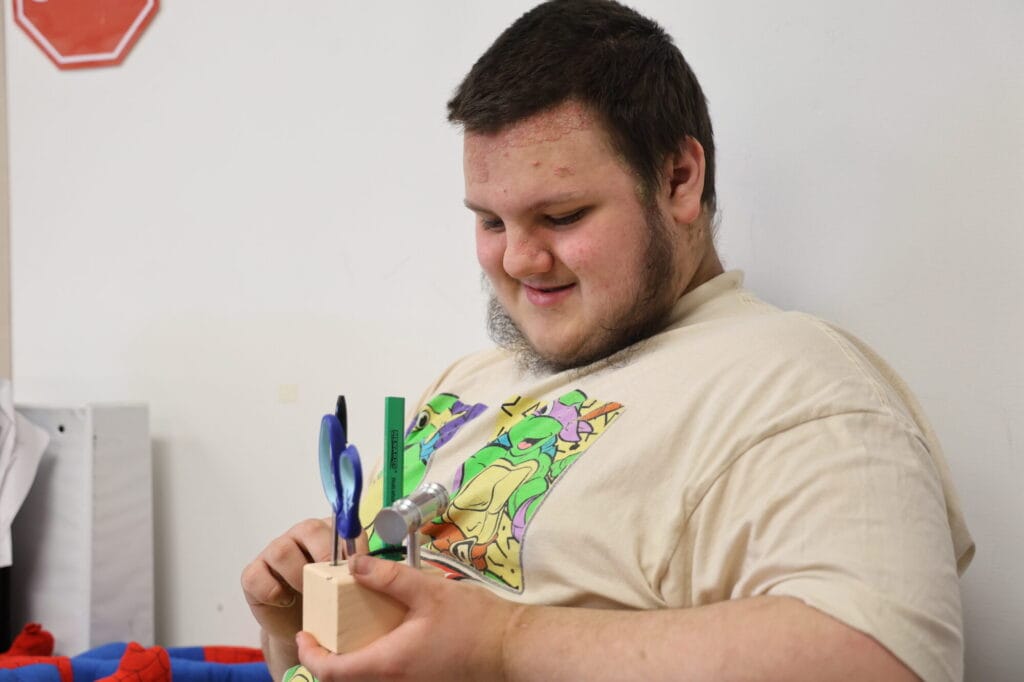Throughout the second trimester, special education students at Burlington High School spent their mornings in the Industrial Technology classroom, where they learned to use everything from saws and drills to spot welders.
It was the first time the Adaptive Industrial Technology class had been offered at BHS, and it won’t be the last.
“It’s been the highlight of my day,” Industrial Tech teacher Aaron Garr said. “I’ve absolutely had a blast. (The students) are just so happy to be given an opportunity to do something different, and I’m looking forward to what the program grows into.”
Garr first learned that he would be teaching an adaptive class at the end of the 2023-24 school year at the request of Career and Technical Education Director Brian Johnson.
“You always want to give that population of student as many different opportunities to experience things as possible,” Johnson said.
Garr, who has an extensive background in manufacturing and is in his second year of teaching, drew from his wife’s experiences working in Vocational Rehabilitation, input from associates and students, and his own teaching experience to plot out the projects.
“I really pushed them. I had them use the equipment — they used the shearer to cut out everything, they spot welded everything,” Garr said. “Then in the (more profound class), the ones who could, I let spot weld and push the spot welder. If they couldn’t, I would try to make them feel included. I would hold their hand and push this button with their finger.”
Garr introduced the students to the various tools around the shop. They built toolboxes and gavels and, at the request of students, pencil holders and bird houses.

“I had them use drill presses to drill holes in blocks,” Garr said. “Well then Josh, he came in and brought his block with him and he said, ‘Mr. Garr, would it be OK if we made pencil and pen holders?’ ”
Garr has been keeping notes on things that went well, such as the toolbox and the pencil holder, and things he could do differently, such as getting an earlier start on a sand casting project and building a sheet metal piggy bank.
The students thoroughly enjoyed it.
“It was great and all that, nice and great,” freshman C.J. Sewell said. “It was pretty fun and I had a lot of enjoyment over there and also we made some gavels.”
The gavels, Sewell said, were his favorite because they’re like what judges use in courtrooms.
It was pretty fun and I had a lot of enjoyment over there, and also we made some gavels.
C.J. Sewell, BHS freshman
Special education teacher Cherie Talbott said the adaptive class empowered her students.
“They absolutely loved it,” Talbott said of her students. “They got to screw in the screws, they got to see how the drill worked, they got to paint things themselves. They felt more independent. It gave them more confidence. It was wonderful, and Mr. Garr is awesome.”
Talbott looks forward to the Adaptive Culinary class her students will take this trimester, where they’ll delve more deeply into some of the life skills that Talbott has been teaching them.
“They will learn kitchen safety, which is super important if they’re ever going to have independence on their own,” Talbott said. “They need that independence, they need to know kitchen safety. They need to know how to follow a recipe. … It’s going to be a wonderful class.”
Garr, whose classroom is located right next to the culinary classroom, plans to stop in and visit the students as often as he can to continue building upon the relationships he has already built with them.
As BHS continues to develop these programs, the focus remains on providing diverse educational experiences that build confidence, independence, and potentially marketable skills for all students, regardless of ability level.
“I feel that our kids need more and more choices, and I think BHS is going in the right direction,” Talbott said.

